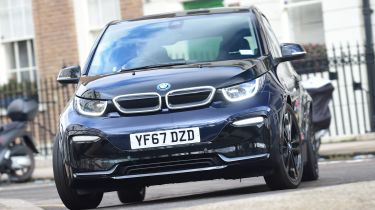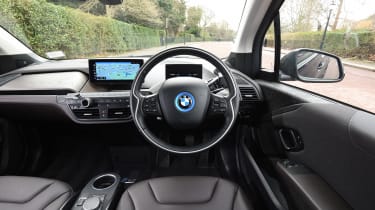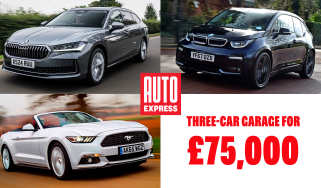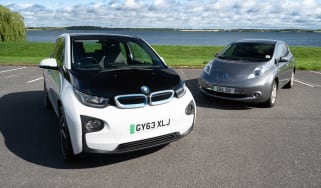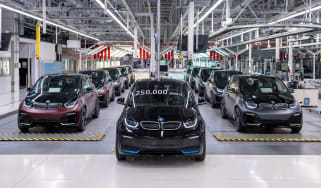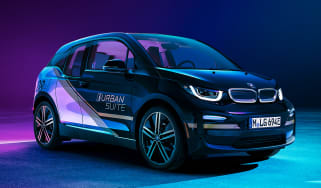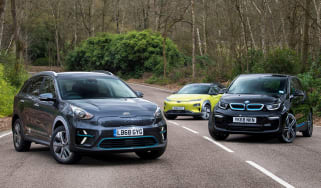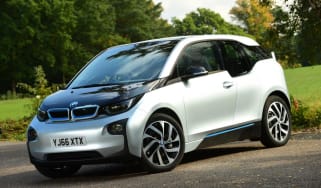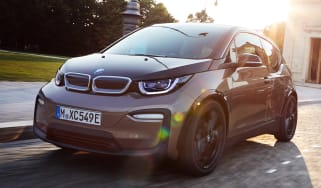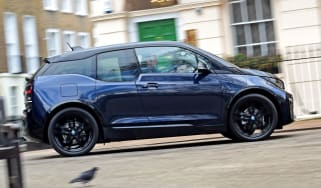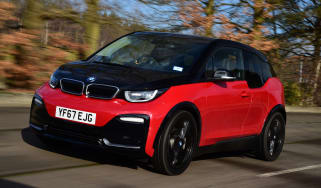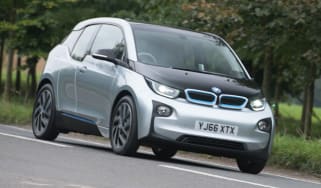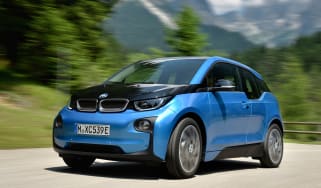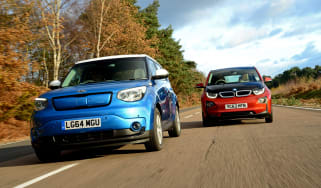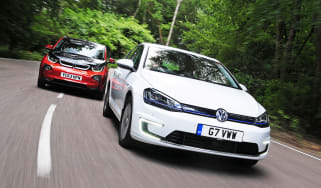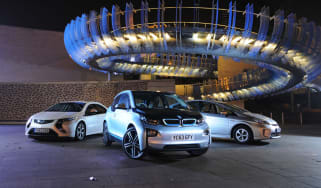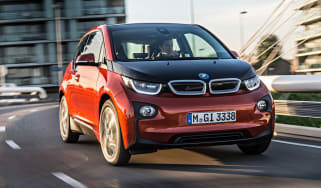BMW i3 (2013-2022) review
The BMW i3 is innovative, stylish and good to drive - delivering a premium small electric car with plenty of road presence

Perhaps no car has signalled the changing of the automotive times in the past decade quite like the BMW i3. Its relatively long lifespan of nine years from its introduction in 2013 to its discontinuation in 2022 has been afforded by its ability to remain fresh in both design and technology.
Available as both a pure-electric model and as a range-extender hybrid throughout most of its life, the i3 offered up a fairly competitive 190 miles of range in its final EV form. While that’s less than you get from a Vauxhall Corsa-e, Peugeot e-208 and even the Renault Zoe, the i3’s build quality, design touches and driving characteristics kept it in the running right up until its production end.
About the BMW i3
While many hatchback-sized, pure-electric cars share their platforms with internal-combustion engined variants, the BMW i3 used a bespoke architecture. This helped give the newly-formed electrified BMW i subdivision some credentials back in 2013, which were further built upon by the plug-in hybrid i8 a year later.
The i3’s platform not only signified BMW’s dedication to the pure-electric market, but it also enabled the i3 to receive updated powertrains through its lifespan. Starting out with a 22.6kWh battery pack (19kWh usable), it offered a rather measly 81 miles of range. A range-extender version sat alongside the i3 from launch, featuring a two-cylinder motorcycle engine from BMW Motorrad; it essentially served as a generator for the battery, pushing range up to 150 miles.
Used - available now

2020 Mercedes
E-Class Coupe
51,000 milesAutomaticPetrol2.0L
Cash £20,995
2021 BMW
iX3
35,741 milesAutomaticElectric
Cash £22,300
2024 FORD
TRANSIT
47,086 milesManualDiesel2.0L
Cash £21,500
2023 Vauxhall
Corsa
10,500 milesAutomaticPetrol1.2L
Cash £15,895In 2017, BMW dropped the range-extender version and replaced the pure-electric model’s battery with a larger 33kWh unit, allowing for a 114-mile range. At the Frankfurt Motor Show of the same year, we saw the facelifted BMW i3 launch with new bumpers front and rear, standard-fit LED headlights and fresh wheel arch trims. Range was improved to 187 miles and a sporty i3s version joined the lineup with a more powerful motor, lowered suspension and a wider track. The inside of the i3 remained virtually unchanged with the latest iDrive system incorporated into the 10.25-inch screen on the dash.
A larger 42.2kWh battery pack was installed in 2019 which bumped up the range to a maximum of 190 miles.
In 2022, BMW announced it would be ending production of the i3. The last i3 rolled off the factory line in Leipzig, Germany in June 2022 - a couple of weeks after global i3 sales notched over 250,000 units.
To mark the occasion, BMW commissioned 18 units of the i3 to celebrate the end of production (in a similar fashion to the final 18 limited edition i8s in 2020), with each example painted in BMW’s Galvanic Gold Metallic.
Engines, performance and drive
The BMW i3 makes use of a ground-up design, advanced construction methods and carbon fibre to keep weight to 1,270kg in the earlier, smaller battery models and 1,365kg in the 42.2kWh cars.
Not only does this weight saving have a positive impact on efficiency and range, but it’s also a huge factor in the way the i3 drives. Around town the i3 feels agile, with responsive and quick steering (it’s only got to direct those ultra-thin, low-resistance tyres) and acceleration is instant thanks to the EV powertrain.
Hit a rough road and you’ll be quickly reminded that the tyres are designed for efficiency over comfort, as is the relatively hard suspension. The i3s, especially with its 20-inch rims and 10mm lower suspension and uprated springs and dampers, does struggle with potholes and bumps.
On country roads the ride settles down and the i3 is less inclined to follow ruts in the tarmac. There’s not much grip afforded by the skinny tyres, and the i3’s rear-wheel drive set-up (including its rear-mounted motor) mean it’s quite easy to find understeer should you push on too enthusiastically. Despite the relatively nippy acceleration (0-62mph in 7.3 seconds for the i3 and 6.9 seconds for the i3s), the i3 never really goads you into sporty driving however.
The silence of the powertrain combined with the high(ish) driving position leaves you feeling the i3 is much more suited to steady, relaxed driving. The brakes go into regeneration mode as soon as you lift off the accelerator and it has quite a forceful braking effect, but unlike some pure-electric cars with regenerative braking, the brake pedal feels positive and there’s no slack in the pedal’s action.
Engines, 0-60 acceleration and top speed
The i3 was available with two powertrains in the latter stages of its life. A 168bhp motor with 250Nm of torque was mated to a single-speed automatic transmission, helping the i3 accelerate from 0-62mph in 7.3 seconds and on to a top speed of 93mph.
The more sporty i3s had a smidge more power at 182bhp and 270Nm of torque (although no M Sport badging) - resulting in a 0-62mph time of 6.9 seconds and a not-so heady 99mph top speed.
Range, charging and running costs
The BMW i3’s range started out at 81 miles; weak considering back in 2013 you could get an updated version of the first generation Nissan Leaf with 124 miles of range.
With its dinky 22.6kWh battery pack, a maximum charge from an optional CCS charge port saw the first i3 being able to replenish plenty of its battery pretty quickly, going from 7 miles to 56 miles of range in 20 minutes.
The range-extender model was launched alongside the fully-electric i3, adding a two-cylinder motorcycle engine that acted as a generator to help maintain battery charge. A maximum range of 150 miles was available from this powertrain.
At the end of its life, the BMW i3 came with a 42.2kWh battery - over double the size of the original’s. This allowed for a maximum 190-mile range.
There’s a choice of Comfort, EcoPro and EcoPro+ drive modes, and the latter two are designed to save energy, with EcoPro+ going as far as switching off the climate control and limiting speed to 56mph to maximise range.
The last of the line i3 could accept a 50kW charge rate which means a 10-80 per cent recharge could be had in 36 minutes. Plug in to a wallbox at home and you’ll have to wait 6 hours and 15 minutes for the i3 to go from 0-100 per cent.
Insurance
The standard model with the range-extender powertrain will be the cheapest i3 to insure, sitting in group 21. The larger battery towards the latter stages of its life means an insurance group of 27 - a couple of groups higher than an equivalent Nissan Leaf. Unsurprisingly, the most sporty i3s version sits in the highest insurance band for the i3 range at 29. The higher insurance band can be attributed to the cost of repairs to that carbon body structure, which could be significant in the event of an accident.
Depreciation
Our expert data predicts the i3 should hold onto around 55 per cent of its original value after a typical ownership period of three-years and 36,000-miles.
To get an accurate valuation on a specific model check out our free car valuation tool...
Interior, design and technology
Sitting on a bespoke platform, the BMW i3 has been designed from the ground up as an EV – and it really shows.
Taking its cues from the BMW i3 Concept that debuted in 2011, the battery-powered car looks like it’s driven straight off a designer’s computer screen, even ten years on.
Tall and narrow proportions give the i3 the look of an MPV rather than a family hatch, but you could argue it stands in a class of its own. Lightweight plastics are used for the heavily sculpted body panels, while the bonnet and glass tailgate get a distinctive gloss black finish. Other highlights include the angular window line, swept-back headlamps and metallic blue trim for the faired-in grille and lower sills.
The futuristic feel continues inside. Access is easy thanks to the rear-hinged doors and lack of a B-pillar – although you have to step over the wide sill. Once in, you’ll be able to enjoy the cleverly packaged and imaginatively designed layout that’s easy to use and beautifully finished. Rear passengers might find it difficult to get into the rear but the front seats do fold forward to make access easier.
Climb into the high-set driver’s seat and the first thing you’ll spot is a pair of large infotainment screens – one ahead of the driver and one that appears to ‘float’ above the centre of the dashboard. These units display everything from speed to sat-nav info, and are controlled via a dial on the centre console. A choice of tactile wooden, metallic, cloth and leather trims are available, bundled into what BMW calls ‘interior worlds’, while the low-set dashboard and vast windscreen create a bright and airy feel.
Because the motor is mounted on the rear wheels and the battery is tucked away in the chassis, the floor is flat. There’s no transmission tunnel dividing the front occupants, leaving just an open space.
Sat-nav, stereo and infotainment
BMW decided not to give the i3 its own bespoke infotainment system, which is good because the standard iDrive is plenty good enough here. The 10-inch screen is set quite far back on the dash, but the graphics are still clear and the response from the iDrive controller on the centre console is crisp.
Elsewhere, there’s a DAB radio, hands-free Bluetooth plus access to a variety of social media, music and email apps. You can also upgrade with a Harman Kardon sound system. Apple CarPlay preparation is included on later cars as well, although you need to register for a free BMW ConnectedDrive account in order to access it.
Practicality, comfort and boot space
The BMW i3 uses clever packaging techniques that electric cars thrive on today. It’s quite a compact car, but the interior space is more akin to something a segment above. The seats are quite high up, but there’s no side bolstering so you can just slide onto them as you would in a van.
There are neat cup-holders, armrest storage and cargo nets, while the glovebox has a top opening lid. The controls are beautifully laid out too.
Sitting in the rear you’ll find plenty of space but you sit quite low down so your knees are a little higher than you’d expect. The sloping angle of the window line lets in plenty of light, although the back windows don’t roll down.
Dimensions and size
At 4,011mm in length it’s shorter than a Nissan Leaf and Renault Zoe but it feels bigger inside than either. With the MPV-like proportions and 1,598 height (taller than the Leaf or Zoe), there’s no qualms when it comes to headroom in the i3, even if you do sit quite high up.
At 1,775mm wide, it’s a tiny bit narrower than a 1 Series, but the excellent visibility you get in the i3 means it’s perfectly suited to city driving as it’s easy to place on the road.
Leg room, head room & passenger space
The BMW is a strict four-seater – there are only two seatbelts in the rear. The rear passengers climb in and out through small rear-opening coach doors that can only be opened when its adjacent front door is open, too. At least the fact there’s no B-pillar in the middle makes it very easy to get in and out.
Boot space
The boot has a high floor, thanks to the running gear underneath, but the 50:50 split seats fold flat.
There’s no loading lip, so you can easily slide things into the 260-litre boot with all the seats in place. Capacity grows to 1,100 litres with the seats folded down.
In the nose, you get a shallow tray for the tyre repair kit, but the cord to open it is hidden behind a panel in the passenger footwell.
Reliability and safety
While BMW has expanded its electric car portfolio in recent years, the i3 stands the test of time in terms of looks but crucially safety as well. Usually getting rid of a B-pillar in a family car would spell disaster for rigidity in crashes, but the i3’s body made up of strong carbon fibre-reinforced plastic structure negates this. There’s also six airbags and standard stability control. However, the bluff front end cost it points in Euro NCAP’s pedestrian assessments – resulting in a disappointing four-star score.
A number of hi-tech safety options were available, though, such as the Driving Assistant Plus. This clever kit brings adaptive cruise control, forward collision alert and Traffic Jam Assist, which will accelerate, steer and brake the car at speeds up to 24mph. A pedestrian warning noise generator was also optional and worked up to around 20mph.
The i3 failed to make it into the 2022 edition of the Driver Power customer satisfaction survey, but BMW ranked 16th out of 29 manufacturers in the survey for customer experience and reliability.
With fewer moving parts than internal-combustion engined cars, the i3 should be simpler to work on and more reliable. Unfortunately, running costs have been reported as poor on the i3, with servicing bills higher than you might think.
Warranty
To help reassure buyers who may be nervous about living with unfamiliar electric drive technology, BMW provided an eight-year and 100,000-mile warranty for the lithium-ion battery pack. The rest of the car – including the electric power system and the motor itself - is covered by a standard three-year guarantee, much like the rest of the BMW range.
Servicing
BMW offers a Pay Monthly Service Plan to help spread the cost of routine maintenance. For electric ‘i’ models, the plan is offered at £15 per month and used i3 buyers can still take advantage of the plan if the original owner bought it with the car being covered for at least the first four years after its registration date.
